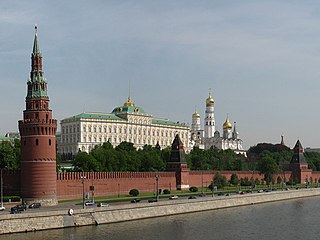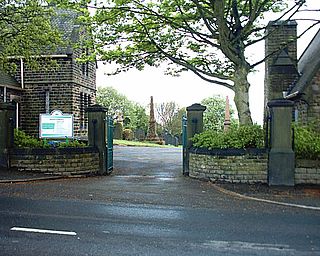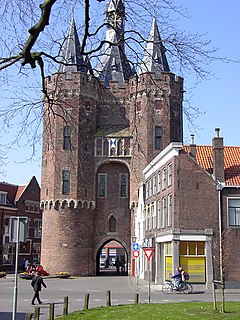
Hattem is a municipality and a town in the eastern Netherlands. The municipality had a population of 12,173 in 2019. The municipality includes the hamlet of 't Zand.

The London Wall was a defensive wall first built by the Romans around the strategically important port town of Londinium in c. AD 200. It has origins as an initial mound wall and ditch from c. AD 100 and an initial fort, now called Cripplegate fort after the city gate (Cripplegate) that was positioned within its northern wall later on, built in 120-150 where it was then expanded upon by Roman builders into a city-wide defence. Over time, as Roman influence waned through the departure of the Roman army in c. 410, their withdrawal led to its disrepair, as political power on the island dispersed through the Heptarchy period of Anglo-Saxon England. From the conquest of William the Conqueror, successive medieval restorations and repairs to its use have been undertaken. This wall largely defined the boundaries of the City of London until the later Middle Ages, when population rises and the development of towns around the city blurred the perimeter.

The Koppelpoort is a medieval gate in the Dutch city of Amersfoort, province of Utrecht. Completed around 1425, it combines land and water-gates, and is part of the second city wall of Amersfoort, which was constructed between 1380 and 1450.

The Amsterdamse Poort is an old city gate of Haarlem, Netherlands. It is located at the end of the old route from Amsterdam to Haarlem and the only gate left from the original twelve city gates.

The Moscow Kremlin Wall is a defensive wall that surrounds the Moscow Kremlin, recognisable by the characteristic notches and its Kremlin towers. The original walls were likely a simple wooden fence with guard towers built in 1156. The Kremlin walls, like many cathedrals in the Kremlin, were built by Italian architects.

York has, since Roman times, been defended by walls of one form or another. To this day, substantial portions of the walls remain, and York has more miles of intact wall than any other city in England. They are known variously as York City Walls, the Bar Walls and the Roman walls. The walls are generally 13 feet (4m) high and 6 feet (1.8m) wide.

Hwaseong Fortress or Suwon Hwaseong is a fortification surrounding the centre of Suwon, the provincial capital of Gyeonggi-do, in South Korea. It was built from 1794 to 1796 by King Jeongjo of the Joseon dynasty to house and honour the remains of his father, Prince Sado. Sado had been executed by being locked alive inside a rice chest by his own father King Yeongjo after failing to obey a command to commit suicide. Located 30 kilometres (19 mi) south of Seoul and enclosing much of central Suwon, the fortress includes King Jeongjo's palace Haenggung. The fortress and enclosed palace were designated as a World Heritage site by UNESCO in 1997. It comprises among many other features the palace, a perimeter wall, four main gates, and two sluicegates over the Suwoncheon, Suwon's main stream, which flows through the centre of the fortress.

The Masmak Fort, also called the Masmak Fortress or Masmak Palace, is a clay and mudbrick fort in ad-Dirah, Riyadh, Saudi Arabia. Built in 1865 for prince 'Abdurrahman ibn Sulaiman AlDabaan under the Emirate of Jabal Shammar, The fortress played an integral role in the Unification of Saudi Arabia, with the Battle of Riyadh, one of the most important conflicts of the Saudi unification, taking place in the fort. Since 1995, the fortress has been converted into a museum showcasing one of the most important landmarks of Saudi heritage.

Norton Cemetery is one of the city of Sheffield's many cemeteries. It was opened on 6 June 1869, and covers 6 acres (24,000 m2).

The Sendlinger Tor is a city gate at the southern extremity of the historic old town area of Munich. It served as a fortification for defence and is one of Munich's three remaining gothic town gates.

The City Hall in Delft is a Renaissance style building on the Markt across from the Nieuwe Kerk. It is the seat of the city's government as well as a popular venue for civic wedding ceremonies. Most administrative functions have been transferred to an office inside the Delft railway station building. Originally designed by the Dutch architect Hendrick de Keyser, it was heavily changed over the centuries and was restored in the 20th century to its Renaissance appearance.

The Grote of Andreaskerk is the oldest church building of Hattem. It is situated in the city centre. It is used by the Reformed Protestant community of Hattem for holding church services. Organ concerts and other musical events are also organised in the building.

The Dairy in the New Garden was built to plans by the master builder, Carl Gotthard Langhans, on the shore of the Jungfernsee lake at the northernmost tip of the New Garden in Potsdam, Germany. Construction was carried out from 1790 to 1792 by Andreas Ludwig Krüger.

The Waag is a 15th-century building on Nieuwmarkt square in Amsterdam. It was originally a city gate and part of the walls of Amsterdam. Later it served as a guildhall, museum, fire station and anatomical theatre, among other things.

The Stratemakerstoren is an early 16th-century bastion on the Waalkade in the Dutch town Nijmegen. It is a rijksmonument and since 1995, it housed a museum. This was closed in April 2015, for major reconstruction.

The Coomanshof is a former hofje in Haarlem, Netherlands, on the Witte Heren straat.

The Gevangenpoort is a former gate and medieval prison on the Buitenhof in The Hague, Netherlands. It is situated next to the 18th-century art gallery founded by William V, Prince of Orange in 1774 known as the Prince William V Gallery.

The Sassenpoort is a gatehouse in the city wall of Zwolle, the Netherlands. It was built in 1409 out of dimension stone, mostly trachyte and tuff, and restoration work was done in 1893-1898. The gatehouse is a rijksmonument and is part of the Top 100 Dutch heritage sites.
The Vischpoort or Vispoort is a late-14th-century city gate and former lighthouse in Harderwijk, Netherlands. The gate, which is located on the historical seaside of the Zuiderzee, is the only one of five gates in the city walls that remains. Between 1851 and 1947 the Vischpoort served as a lighthouse. The Vischpoort is listed as a national heritage site.

The 'Drommedaris' is the southern gateway of the city Enkhuizen. It is the best known building in Enkhuizen.






















